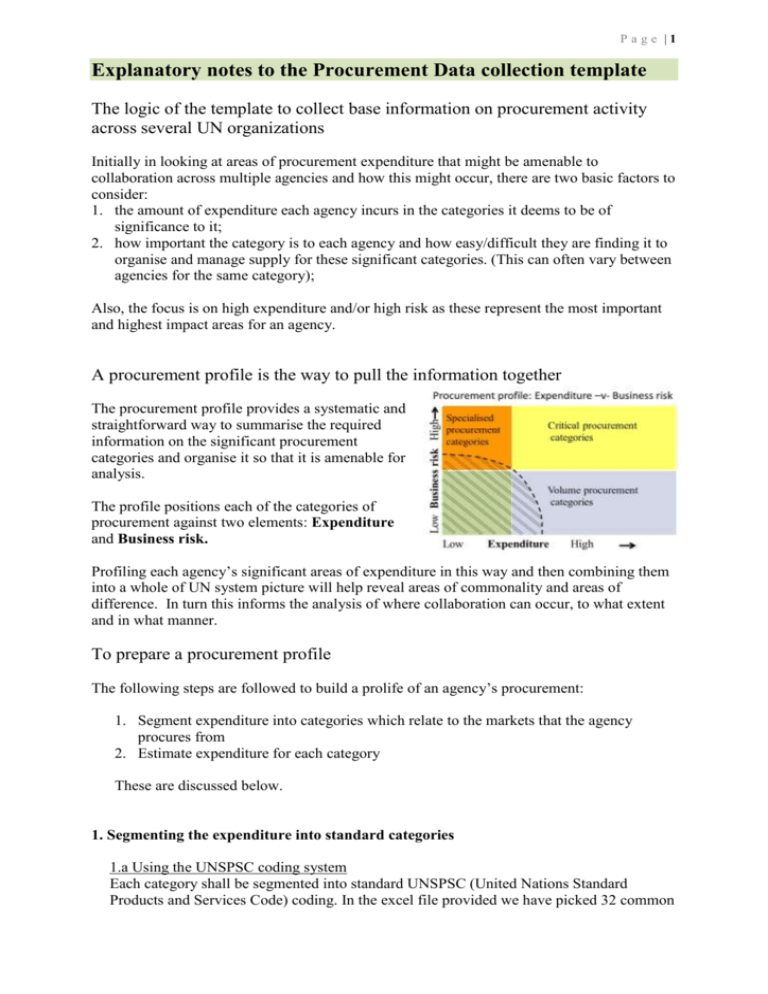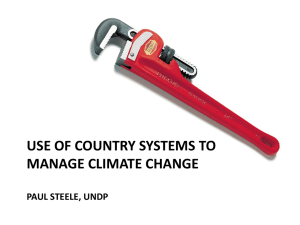A.13 Local procurement data collection (Explanatory
advertisement

P age |1 Explanatory notes to the Procurement Data collection template The logic of the template to collect base information on procurement activity across several UN organizations Initially in looking at areas of procurement expenditure that might be amenable to collaboration across multiple agencies and how this might occur, there are two basic factors to consider: 1. the amount of expenditure each agency incurs in the categories it deems to be of significance to it; 2. how important the category is to each agency and how easy/difficult they are finding it to organise and manage supply for these significant categories. (This can often vary between agencies for the same category); Also, the focus is on high expenditure and/or high risk as these represent the most important and highest impact areas for an agency. A procurement profile is the way to pull the information together The procurement profile provides a systematic and straightforward way to summarise the required information on the significant procurement categories and organise it so that it is amenable for analysis. The profile positions each of the categories of procurement against two elements: Expenditure and Business risk. Profiling each agency’s significant areas of expenditure in this way and then combining them into a whole of UN system picture will help reveal areas of commonality and areas of difference. In turn this informs the analysis of where collaboration can occur, to what extent and in what manner. To prepare a procurement profile The following steps are followed to build a prolife of an agency’s procurement: 1. Segment expenditure into categories which relate to the markets that the agency procures from 2. Estimate expenditure for each category These are discussed below. 1. Segmenting the expenditure into standard categories 1.a Using the UNSPSC coding system Each category shall be segmented into standard UNSPSC (United Nations Standard Products and Services Code) coding. In the excel file provided we have picked 32 common P age |2 procurement categories for your reference when filling in the Template worksheet. If there are other significant categories of procurement expenditure that you would like to record, kindly add them by using the UNSPSC website (http://www.unspsc.org/default.aspx ). Please note that you can either download the UNSPSC codeset and search your category or put the code name in the search box (top left side in the UNSPSC website). The UNSPSC for a given item is composed of five two-digit identifiers, which together categorize the item into a five-level hierarchy. The five levels of the classification are "Segment", "Family", "Class", "Commodity", and "Business Function". Once you identify your category please record it in the provided Excel template. 1.b Knowing the major areas of expenditure in your agency If your agency does not already capture information of procurement activity under procurement categories then the following approach can give you an indication of where the expenditure is occurring. Approach the Finance or Budget area and advise them what you are wanting to do Look at your agency’s General Ledger (GL) account codes and pick out the codes, based on their name and description, that are likely to be where expenditure on goods and services are recorded Ask the Finance/Budget area to run a report on expenditure in the past year posted to those GL account codes For the top (by level of expenditure) 20 to 40 GL account codes – and as a rule of thumb stop when you get to over 80% of expenditure - have the Finance/Budget area also provide a list of the top 5 vendors by expenditure and the top 5 Cost Centres, by expenditure, for each of these GL account codes. That should be sufficient information to work out what procurement categories your agency’s GL accounts codes roughly correlate with. In doing this you need to appreciate that there will not be a one to one mapping of GL account codes and procurement categories. The accounting system’s coding structure is set up for financial management purposes whereas procurement categories are more aligned with supply markets and goods/services being procured. The result is that there are a lot of similarities but they are not the same. Therefore having some information on major vendors and cost centres (as per the information in the 4th dot point above) will help you in allocating the expenditure recorded against the GL accounts to the procurement categories. Note: Do not try and get a perfect match. For this first pass level of analysis of the data, an approximation is sufficient. 2. Estimate expenditure for each category For goods and services procured year on year, provide an estimate of the annual expenditure. If the expenditure varies from year to year provide an average. Note: It is not necessary for this exercise to have a highly accurate figure. What is needed is an approximation of likely expenditure. A detailed analysis of expenditure in a category, if required, can occur when HLCM members that it is a category for further collaborative work. P age |3 For large, one-off procurement projects that do not occur year on year use an estimate of expenditure for the project overall, even though this may extend over several years. The template provides for this reference to be made, if required.







